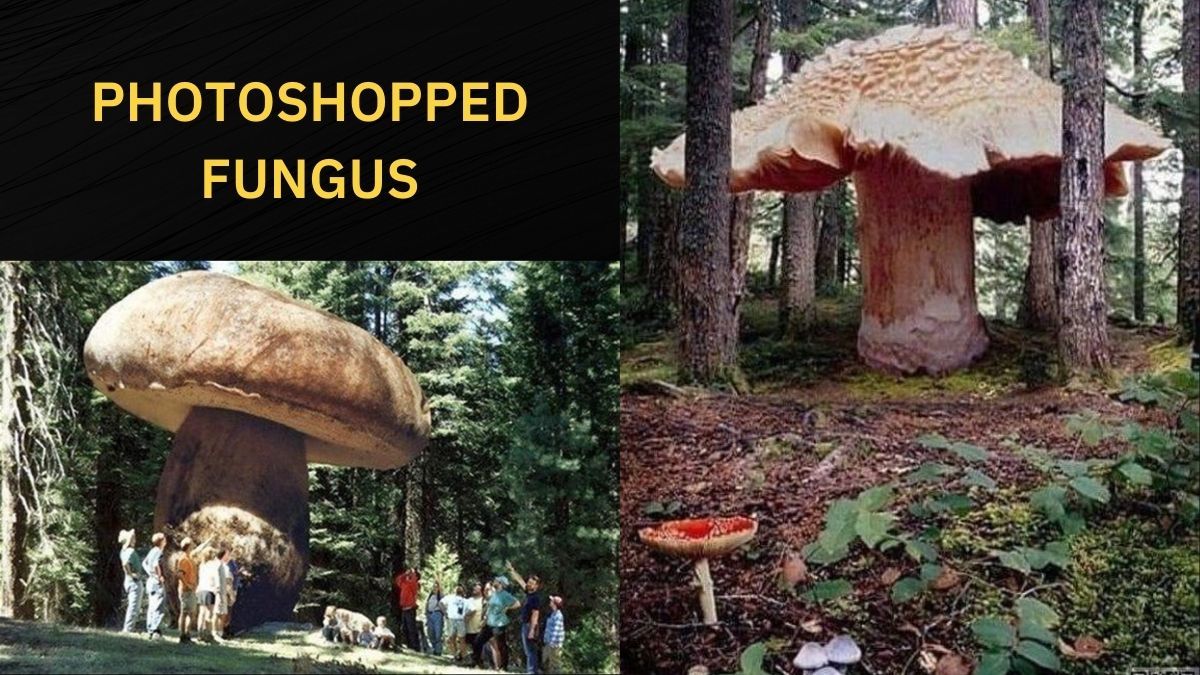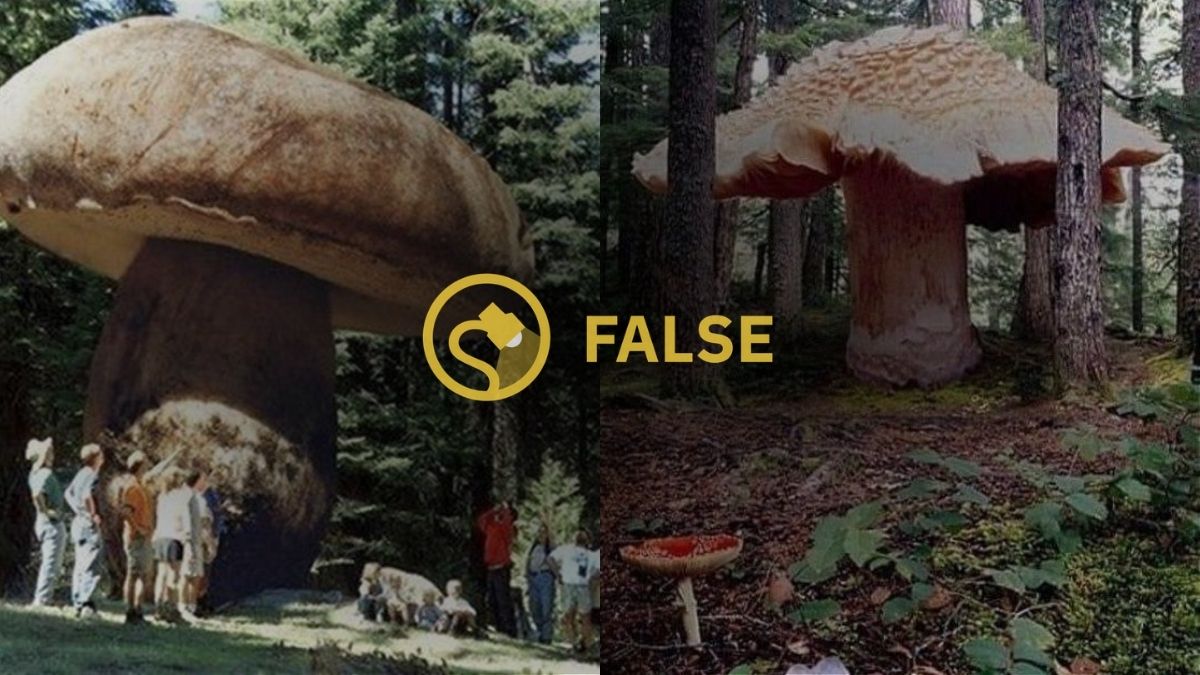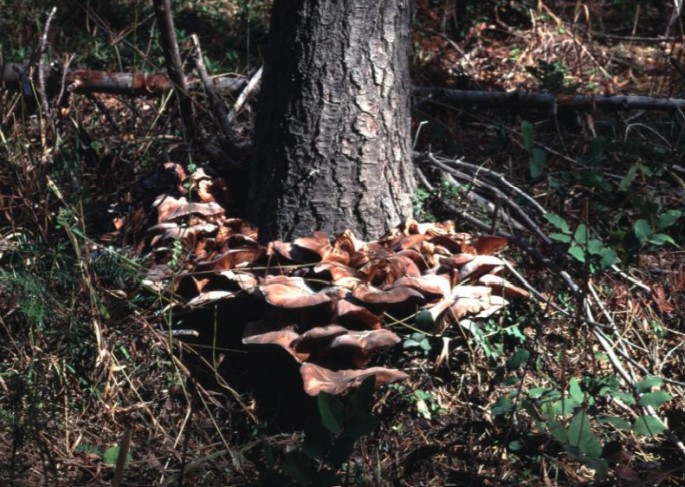These viral photographs showing a giant, single mushroom are fake. While the "world's largest mushroom" may conjure up images of one single enormous spore, Armillaria ostoyae, or the honey mushroom, is actually a sprawling organism that covers acres of forest floor.
A pair of images supposedly showing the "world's largest mushroom" in Oregon are frequently circulated on social media along with a piece of text describing the Armillaria ostoyae, or the honey mushroom.
These images are frequently accompanied by a piece of text about honey mushrooms, such as this paragraph that went viral when it was posted to Facebook in May 2021:
"Giant mushroom, Oregon ......... Armillaria ostoyae, commonly known as the honey mushroom, is bigger than most animals, and is considered the largest and oldest organism on Earth. The mushroom covers 3,726563 m 2 of Malheur National Forest, Oregon, and is estimated to be around 8,650 years old."
While Armillaria ostoyae is a real mushroom and is considered to be one of the largest and oldest organisms on earth, it is not pictured in these images. The above-displayed images are the result of photo manipulation.
The "largest mushroom in the world" may conjure up images similar to the giant individual mushrooms shown in these viral photographs. However, Armillaria ostoyae's impressive growth takes place across (and under) the ground, not up into the air. The U.S. Department of Agriculture (USDA) writes that this "humongous fungus" is spread out across thousands of acres of the Malheur National Forest. Since this is a single organism, it is considered to be the largest mushroom in the world, but photographs of this humongous fungus are not quite as impressive as the fake photos shown above.
Here's a genuine picture of Armillaria ostoyae from the USDA:
The BBC explained:
The parasitic and apparently tasty honey fungus not only divides opinions; it is also widely seen as the largest living organism on Earth.
More precisely, a specific honey fungus measuring 2.4 miles (3.8 km) across in the Blue Mountains in Oregon is thought to be the largest living organism on Earth.
Several species of fungi belong to the Armillaria genus, which is popularly known as honey fungus. They colonise and kill a variety of trees and woody plants.
The large clumps of yellow-brown mushrooms that appear above ground are the fruiting bodies of much larger organisms. They consist mainly of black bootlace-like rhizomorphs that spread out below surface in search of new hosts, and underground networks of tubular filaments called mycelia.
As for these digitally edited works of fantastical fungus, we've been able to track down the source of one of them. The image showing a group of people staring up at a humongous fungus was created circa 2000 by a fungal biology student at the University of California, Berkeley. This image was created as a joke by Dirk Redecker, who is now a microbiologist and curator for the International Bank for the Glomales (an order of symbiotic fungi) at the French National Institute for Agricultural Research. We reached out to Redecker for comment and will update this article if more information becomes available.
When Waffles at Noon reached out to Tom Bruns, Professor Emeritus of Fungal Ecology at Berkeley, for more information about this photo, he identified the mushroom as "Boletus photoshopus" and noted that it was pictured in its natural habitat, the digital photo.
Bruns elaborated on the origins of this image in an email to Snopes. Bruns told us that this fake image was made circa 2000 as a "fun lab portrait." Bruns and his then-student Redecker used an image of a Boletus rex-veris, a mushroom that stands about 8 inches tall, to create the giant mushroom pictured in this image. Bruns said:
"It was made during some fieldwork in the Dinky Creek area of Sierra National forest in the early 2000s as a fun lab portrait. The species is Boletus rex-veris, which was maybe 8” tall. Dirk Redecker and I collaborated on this. The idea and staging was mine, and the photoshop wizardry was Dirk's. Over the years I used it in public and scientific talks and class lectures as a joke slide. It was also on the lab website for ages along with other humorous material. A printed version of this was sent as a gift to me from Dirk, and it still hangs on my wall at home. A second printed version was send as a gift to the late Prof Orson Miller."
We have not been able to source the second image. However, we can say with absolute certainty that it is not a genuine photo of a fantastically large fungus. In fact, the Malheur National Forest has commented on this fake photo, writing: "Every few months a new crazy giant mushroom image shows up on social media referring to the Humongous Fungus on the Malheur National Forest. While it is true the fungus is the largest living organism it looks nothing like this."



